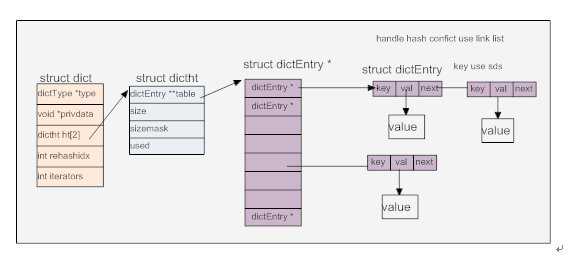标签:
前面提到Redis是个key/value存储系统,学过数据结构的人都知道,key/value最简单的数据结果就是哈希表(当然,还有其他方式,如B-树,二叉平衡树等),hash表的性能取决于两个因素:hash表的大小和解决冲突的方法。这两个是矛盾的:hash表大,则冲突少,但是用内存过大;而hash表小,则内存使用少,但冲突多,性能低。一个好的hash表会权衡这两个因素,使内存使用量和性能均尽可能低。在Redis中,哈希表是所有其他数据结构的基础,对于其他所有数据结构,如:string,set,sortedset,均是保存到hash表中的value中的,这个可以很容易的通过设置value的类型为void*做到。本文详细介绍了Redis中hash表的设计思想和实现方法。
【注】 本文的源代码分析是基于redis-2.4.3版本的。
下图是从淘宝《Redis内存存储结构分析》中摘得的图片,主要描述Redis中hash表的组织方式。

在Redis中,hash表被称为字典(dictionary),采用了典型的链式解决冲突方法,即:当有多个key/value的key的映射值(每对key/value保存之前,会先通过类似HASH(key) MOD N的方法计算一个值,以便确定其对应的hash table的位置)相同时,会将这些value以单链表的形式保存;同时为了控制哈希表所占内存大小,redis采用了双哈希表(ht[2])结构,并逐步扩大哈希表容量(桶的大小)的策略,即:刚开始,哈希表ht[0]的桶大小为4,哈希表ht[1]的桶大小为0,待冲突严重(redis有一定的判断条件)后,ht[1]中桶的大小增为ht[0]的两倍,并逐步(注意这个词:”逐步”)将哈希表ht[0]中元素迁移(称为“再次Hash”)到ht[1],待ht[0]中所有元素全部迁移到ht[1]后,再将ht[1]交给ht[0](这里仅仅是C语言地址交换),之后重复上面的过程。
Redis哈希表的实现位于文件dict.h和dict.c中,主要数据结构如下:
|
1
2
3
4
5
6
7
8
9
10
11
12
13
|
//hash表结构typedefstructdictht { dictEntry **table; //hash 表中的数据,以key/value形式,通过单链表保存 unsigned longsize; //桶个数 unsigned longsizemask; //size-1,方便定位 unsigned longused; //实际保存的元素数} dictht; |
|
1
2
3
4
5
6
7
8
9
10
11
12
13
14
15
|
//hash表结构,含有两个hash表,以实现增量再hash算法。typedefstructdict { dictType *type; //hash表的类型,可以是string, list等 void*privdata; //该hash表的一些private数据 dictht ht[2]; intrehashidx; /* rehashing not in progress if rehashidx == -1 */ intiterators; /* number of iterators currently running */} dict; |
|
1
2
3
4
5
6
7
8
9
10
11
|
//hash表中每一项key/value,若key的映射值,以单链表的形式保存typedefstructdictEntry { void*key; void*val; structdictEntry *next;} dictEntry; |
|
1
2
3
4
5
6
7
8
9
10
11
12
13
14
15
16
17
|
//每种hash table的类型,里面既有成员函数,又有成员变量,完全是模拟的C++类,注意,每个函数带有的privdata均为预留参数typedefstructdictType { unsigned int(*hashFunction)(constvoid*key); //要采用的hash函数 void*(*keyDup)(void*privdata, constvoid*key); //对key进行拷贝 void*(*valDup)(void*privdata, constvoid*obj); //对value进行拷贝 int(*keyCompare)(void*privdata, constvoid*key1, constvoid*key2);//key比较器 void(*keyDestructor)(void*privdata, void*key);//销毁key,一般为释放空间 void(*valDestructor)(void*privdata, void*obj);//销毁value,一般为释放空间} dictType; |
Redis中hash table主要有以下几个对外提供的接口:dictCreate、dictAdd、dictReplace、dictDelete、dictFind、dictEmpty等,而这些接口调用了一些基础操作,包括:_dictRehashStep,_dictKeyIndex等。下面分析一下_dictRehashStep函数:
该函数主要完成rehash操作。Hash Table在一定情况下会触发rehash操作,即:将第一个hash table中的数据逐步转移到第二个hash table中。
【1】触发条件
|
1
2
3
4
5
6
7
8
9
10
11
12
13
14
15
|
//dict.c, _dictExpandIfNeeded()if(d->ht[0].used >= d->ht[0].size && (dict_can_resize || d->ht[0].used/d->ht[0].size > dict_force_resize_ratio)){ returndictExpand(d, ((d->ht[0].size > d->ht[0].used) ? d->ht[0].size : d->ht[0].used)*2);} |
当第一个表的元素数目大于桶数目且元素数目与桶数目比值大于5时,hash 表就会扩张,扩大后新表的大小为旧表的2倍。
【2】转移策略
为了避免一次性转移带来的开销,Redis采用了平摊开销的策略,即:将转移代价平摊到每个基本操作中,如:dictAdd、dictReplace、dictFind中,每执行一次这些基本操作会触发一个桶中元素的迁移操作。在此,有读者可能会问,如果这样的话,如果旧hash table非常大,什么时候才能迁移完。为了提高前移速度,Redis有一个周期性任务serverCron,每隔一段时间会迁移100个桶。
|
1
2
3
4
5
6
7
8
9
10
11
12
13
14
15
16
17
18
19
|
//redis.cintdictRehashMilliseconds(dict *d, intms) { longlongstart = timeInMilliseconds(); intrehashes = 0; while(dictRehash(d,100)) { rehashes += 100; if(timeInMilliseconds()-start > ms) break; } returnrehashes;} |
下面分析一下dictAdd函数:
首先,检查hash table是否正在rehash操作,如果是,则分摊一个rehash开销:
|
1
|
if(dictIsRehashing(d)) _dictRehashStep(d); |
然后,检查该key/value的key是否已经存在,如果存在,则直接返回:
|
1
2
3
|
if((index = _dictKeyIndex(d, key)) == -1) returnDICT_ERR; |
需要注意的是,决定是否需要进行rehash是在查找操作(_dictKeyIndex)中顺便做的:
|
1
2
3
4
5
|
//_dictKeyIndex()if(_dictExpandIfNeeded(d) == DICT_ERR) return-1; |
接着,会通过hash算法定位该key的位置,并创建一个dictEntry节点,插入到对应单链表中:
|
1
2
3
4
5
6
7
|
entry = zmalloc(sizeof(*entry));entry->next = ht->table[index];ht->table[index] = entry;ht->used++; |
最后将key/value对填充到该entry中:
|
1
2
3
|
dictSetHashKey(d, entry, key);dictSetHashVal(d, entry, val); |
这就是整个dictAdd函数的流程。其他操作类似,均是刚开始分摊rehash开销(如果需要),然后通过hash方法定位位置,并进行相应的逻辑操作。
原创文章,转载请注明: 转载自董的博客
作者:Dong,作者介绍:http://dongxicheng.org/about/
本博客的文章集合:http://dongxicheng.org/recommend/
标签:
原文地址:http://www.cnblogs.com/lsx1993/p/4632430.html